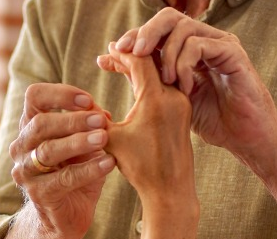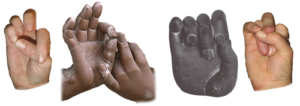InnerDialogue is built upon a somatosensory language that connects with all the levels of the neurological body.
Introduction to Mudras – The Language Beneath the Story


These simple yet profound hand gestures, known as mudras, form the foundation of our practice. They serve as a kind of protolanguage—a language older than words—that allows us to access and respond to the deeper narratives carried within a person. By placing gesture after gesture, we begin to uncover the hidden dialogue behind a state, symptom, or inquiry. Mudras become phrases, paragraphs, even chapters in a person’s life, revealing old patterns, forgotten truths, internal resources, and the very roots—aetiology—of their current condition. They point toward healing, transformation, and emergence.
Gestures: An Ancient Language
Before spoken language existed, gestures were the primary means of communication. Animals still use them instinctively—to warn, attract, alert, or signal danger. Higher mammals, such as chimpanzees and gorillas, exhibit complex gestural systems, as observed both in the wild and in research settings, including the work of Beatrix and Allen Gardner, and later Roger Fouts, who taught sign language to primates.
In human prehistory, especially among tribal and indigenous groups with many dialects, gestures developed as a universal lingua franca. When travellers or strangers entered unfamiliar territory, they relied on hand signs to express intent, need, or peacefulness—especially where spoken language was a barrier.
Even newborns display rudimentary gestures. Despite an undeveloped nervous system, infants communicate discomfort or need through distinctive hand shapes—sometimes subtle, sometimes striking. Clinically, these finger formations can correspond directly to bodily dysfunction. After decades of practice, we now recognise that many of these infant gestures mirror therapeutic modes used in our work today.
Mudras in Culture and Tradition
Mudras are found across many cultures, particularly in spiritual, ritual, and artistic contexts. In classical Indian dance and yogic traditions, they are vital expressions of story, intention, and state. Ancient sculptures and paintings often depict sages, deities, or saints in precise hand positions that signify profound truths, blessings, or states of being.
The Sanskrit word mudrā can be translated as “seal” or “mystery.” In ancient Iranian Akkadian, the related word musara referred to objects bearing sacred or royal inscriptions. Whether in iconography or ritual, mudras often signified a hidden authority or embodied truth.
In East Asia, mudras were integrated into various disciplines, including martial arts, monastic practices, and spiritual traditions. The Shaolin monks of China, for example, used mudras as part of their meditative and martial training—gestures that both instilled inner clarity and invoked strength.
Western Christianity also holds traces of this tradition. In Eastern Orthodox iconography, Jesus, the saints, and apostles are depicted using specific hand signs. Some of these gestures form the Greek initials for “Jesus Christ,” while others remain enigmatic, transmitting Grace, protection, or spiritual initiation through symbolic gesture. Over centuries, these signs were copied, venerated, and meditated upon—without always being fully understood.
Mudras as a Living Language
Today, we use mudras not only ritually but therapeutically—as a living language that speaks directly with the body and being. In combination with ontological kinesiology—an evolved form of muscle testing rooted in the body’s truth—mudras enable us to engage in dialogue with the individual’s inner essence.
Through this language, we may ask:
-
What occurred that led to this state?
-
What story is being carried or repressed?
-
Where has connection been lost?
This approach cuts across conventional models of illness. Rather than diagnosing from the outside, we listen from within. The body, through gesture, reveals the energetic or narrative disconnection at the root of a person’s difficulty: a collapse in self-value, a trauma held in tissue, a disordered sense of identity or purpose.
When these stories are uncovered, the individual begins to reorient themselves to Life—what some traditions call the Great Life or the Source. As they do, healing becomes not just the resolution of symptoms but a return to coherence, essence, and wholeness.